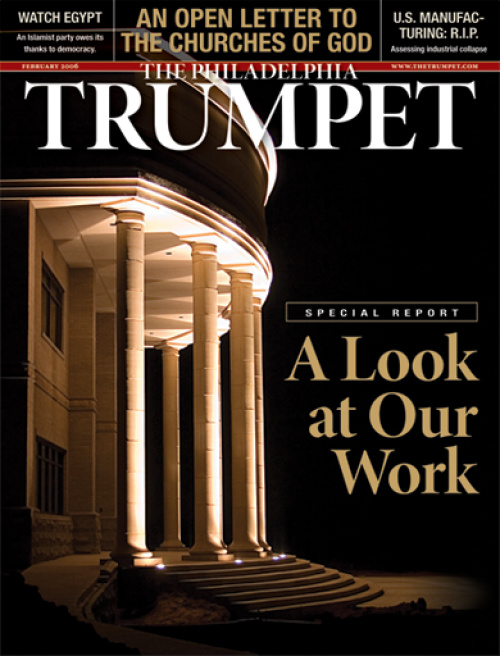What Is News?

What Is News?
Judging by the amount of news people consume, we’re all bona fide news junkies. We have broadcast news, cable news 24/7/365, radio news, news journals and newsmagazines, newspapers and Internet news. We are plugged in.
But plugged in to what, exactly? What is news? Given the dizzying nature of our simultaneously vast-and-tiny, mass-communication-saturated world of nearly 6½ billion people, as we seek to learn about it we have to be very selective. (Even the bbc does, and it’s the world’s largest news organization.) Thus, we tend to fixate on what tickles our curiosity, what swells or pinches our pocketbooks, and what helps or harms our loved ones.
But how do the professionals pick what to report on and how? I challenge you to think about it. Because the publication you’re reading uses an entirely different criterion than any other source out there.
Defining what makes news has to begin with watching. In order to better manage the overwhelming task of surveillance, news outlets carve the world into chunks—geographic areas, politics, economy, sports, health, specific organizations and so on. They must decide where to position their reporters—decisions that reflect certain prejudices: A president is more important than a policeman; Manhattan is more important than Minidoka. A harried assignment editor—monitoring multiple newswires, tv channels, police radio broadcasts and phone tips—will tend to allocate reporters to what looks potentially most dramatic: conflict-driven, telegenic, “man bites dog.” Money is also a factor: It costs more to send the reporter farther away and/or for longer periods; not to mention that there are only so many of them—if they’re all already assigned, everything else slips through the cracks. It’s an obvious truth, but worth stating: No matter how important an event may actually be, if the newsman misses it, it ain’t news.
The reporter on the scene has plenty of decisions to make too: Who are worthwhile sources? Which details matter? How much background is necessary to understand this? Does it represent a larger trend or is it deviant? His perspective—limited and flawed as it may be—will affect all of these choices and shape the way he conveys that event.
News directors and editors must determine which of the stories that come in will fill the 23 minutes of that night’s broadcast, or tomorrow’s paper. And not just to determine whether the story will air or be printed, but also its prominence: where to put it and for how long, how to sell it, whether to pair it with other stories. Criteria for making these determinations are manifold: the story’s timeliness, proximity to the audience, level of drama, celebrity of the subject, how many people it affects and so on. They must also factor in suitability for the particular medium; balance with other reports; resources invested (it’s not much of a story, but we’ve spent the money so we’ll go with it); organizational policy; ideological slant; sense of public need or taste; need for ratings/subscribers; accountability to advertisers. Throw in an O.J. or M.J. criminal trial and the whole calculus can get upended for month after interminable month.
Up and down the chain—from the spark of an idea to the finished news product—these judgments are intrinsic to the process. In other words, creating news is not a science. As journalist Walter Lippmann once pointed out, news is not the same as truth. It is a concoction—based on reality but fundamentally limited, partial and artificial. A discerning consumer shouldn’t accept it at face value.
The Trumpet magazine faces many of the same decisions as we monitor world events: What will we cover? How should we write about it? How much space should we give it? What will we feature on our cover? We grapple with limited intelligence, personal assumptions and flawed perceptions as much as everyone else.
In some basic ways, however, we are quite different from any other source from which you may receive news. For one, producing a free publication means we have no accountability to advertisers and little need to adjust our content in order to pander to subscribers.
But the key difference is the primary criterion we use to determine a story’s newsworthiness. It transcends and supercedes all other criteria by a vast margin—and is completely ignored by every other news outlet. Where other criteria swing and fluctuate and can suck the process toward silliness, this keeps it focused like a laser beam on what truly is—even in an absolute sense—important.
That criterion is prophetic significance.
In order to prove His omnipotence, millennia ago God recorded in Scripture descriptions of future events, and is now bringing them to pass (Isaiah 42:9; 46:9-10; 48:3-5). These provide signposts pointing to the imminence of Jesus Christ’s Second Coming—an event which the Messiah Himself told us to prepare ourselves for by watching and praying (Luke 21:36).
To us, news is much more than a curiosity. As we watch events aligning, bit by bit, step by step, with the prophetic view spelled out in the Holy Bible by the living God, it is proof positive that “the most High ruleth in the kingdom of men” (Daniel 4:17) and that He is about to bring justice to this weary world. Thus, our message has driving purpose: to inform, to witness, yes—but also, hopefully, to motivate and inspire. The fact that each story has been chosen for its prophetic significance carries this urgent, implicit message: Seek God while He may be found.
